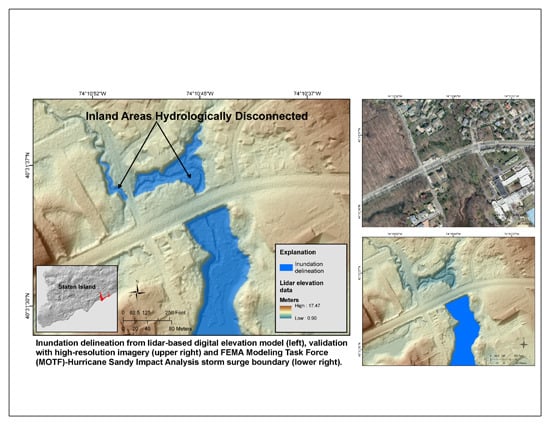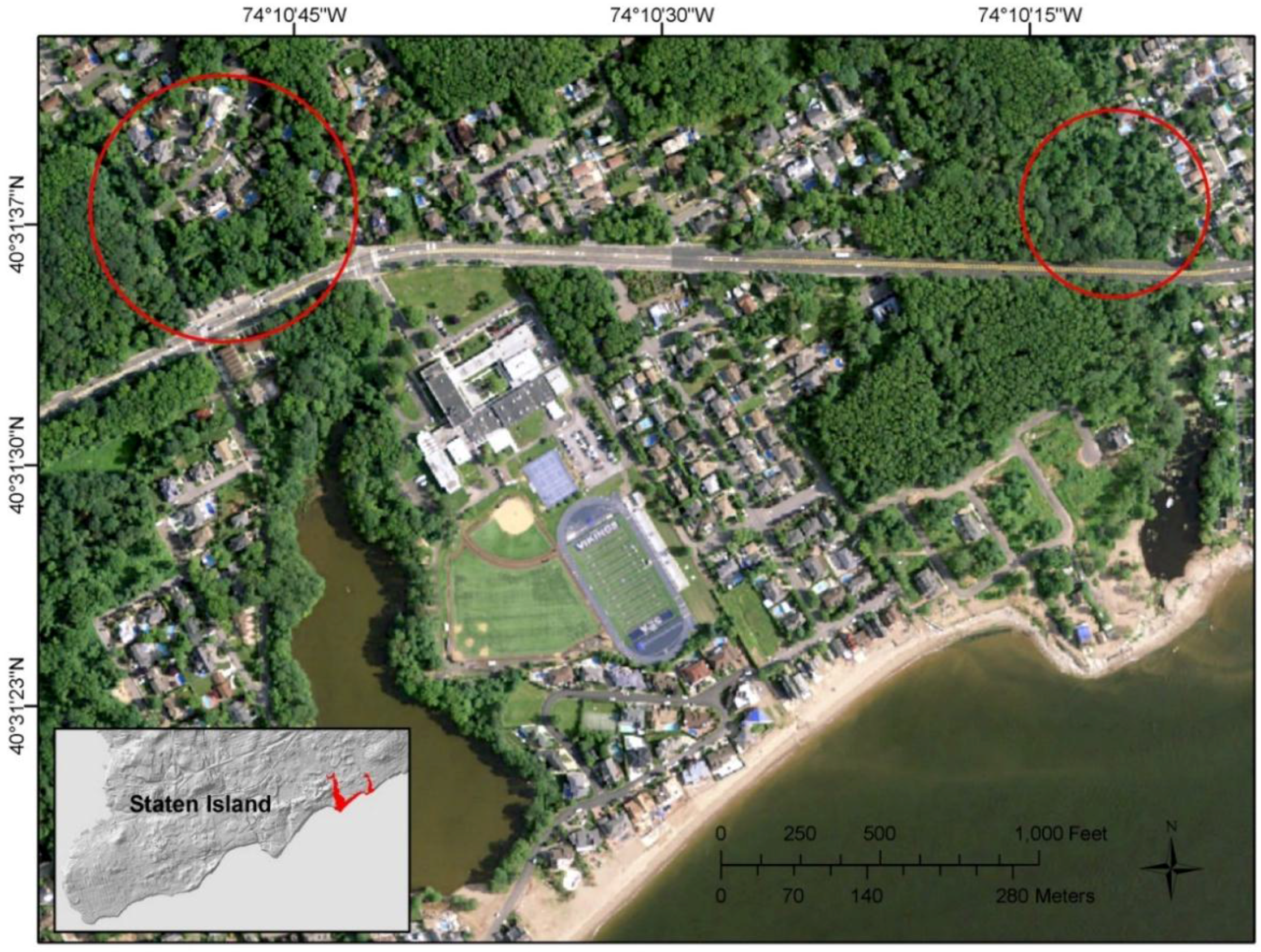Evaluation of Airborne Lidar Elevation Surfaces for Propagation of Coastal Inundation: The Importance of Hydrologic Connectivity
Abstract
:1. Introduction/Background
2. Study Area
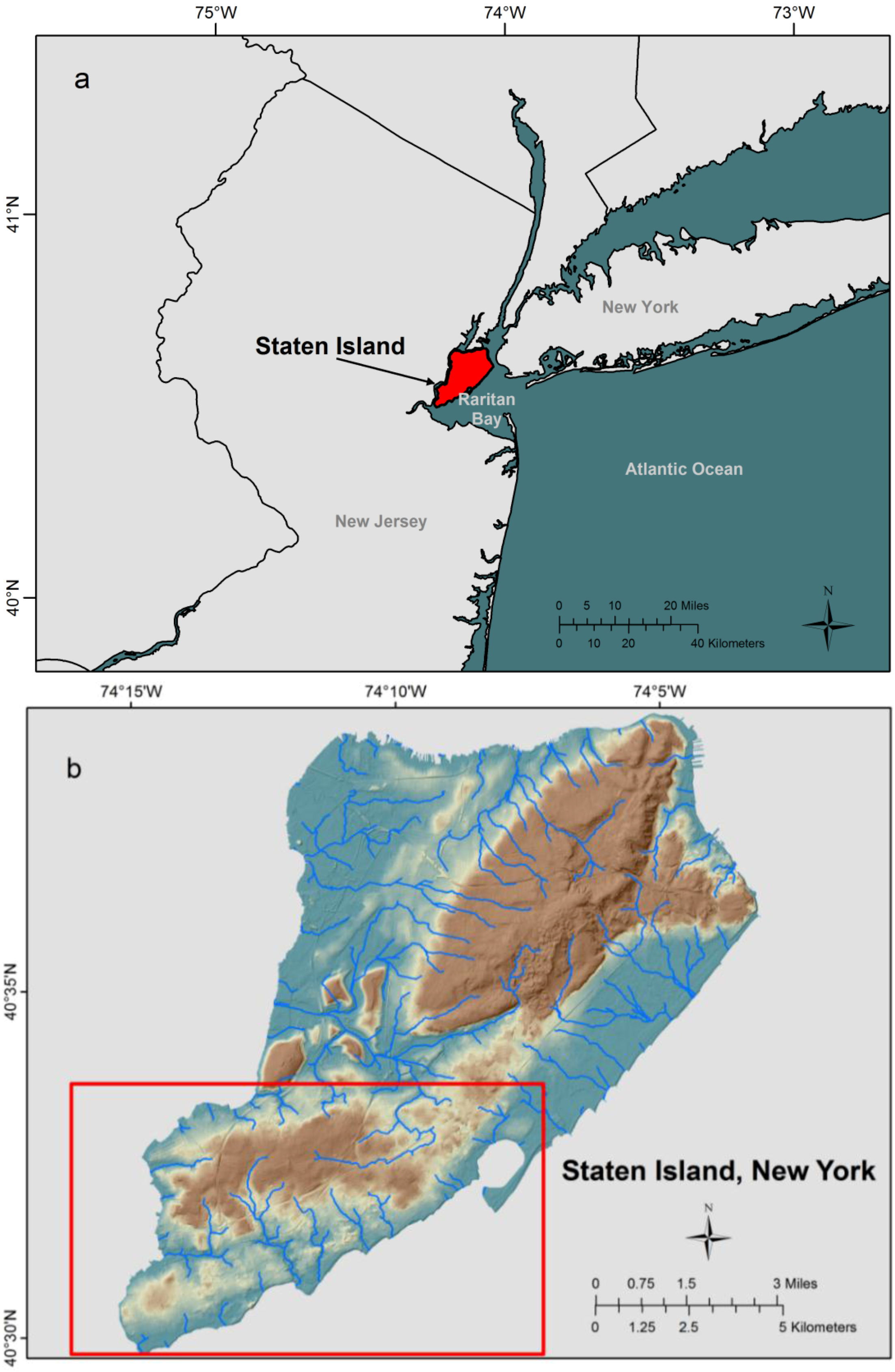
3. Methods
3.1. Data and Pre-Processing
3.2. Propagation of Flood Waters in a Lidar Elevation Surface
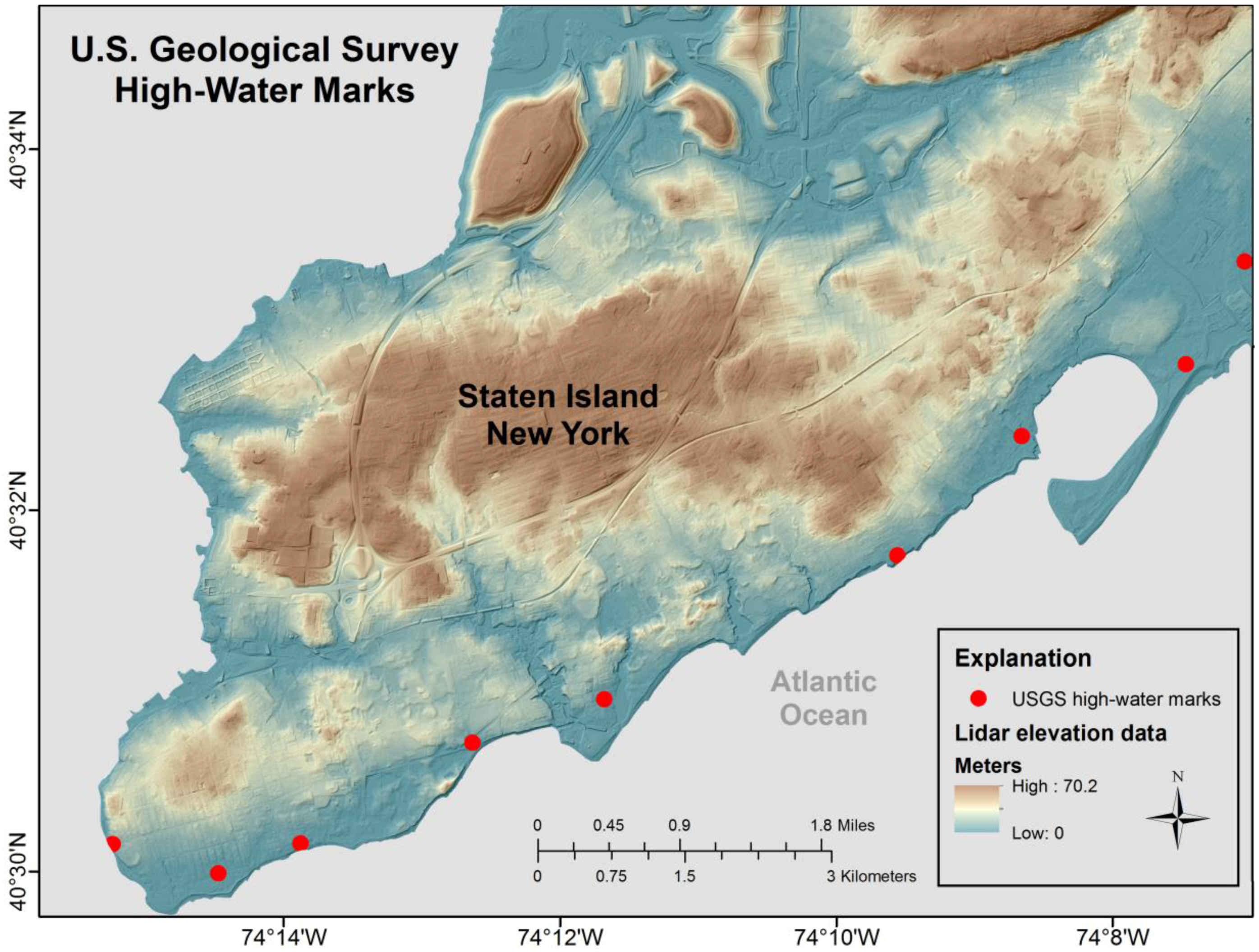
| Ground Surface Elevation (m) | High-Water Mark Height above Ground Surface Elevation (m) | Ground Surface Elevation and High-Water Mark Elevation (m) |
|---|---|---|
| 3.99 | 0 | 3.99 |
| 4.02 | 1.69 | 5.71 |
| 4.02 | 0 | 4.02 |
| 3.96 | 0 | 3.96 |
| 2.99 | 0 | 2.99 |
| 3.99 | 0.29 | 4.28 |
| 5.15 | 0 | 5.15 |
| 4.27 | 0 | 4.27 |
| 3.81 | 2.40 | 6.21 |
| -- | Mean | 4.51 |
4. Results and Discussion
4.1. Hydrologically Disconnected Inland Areas
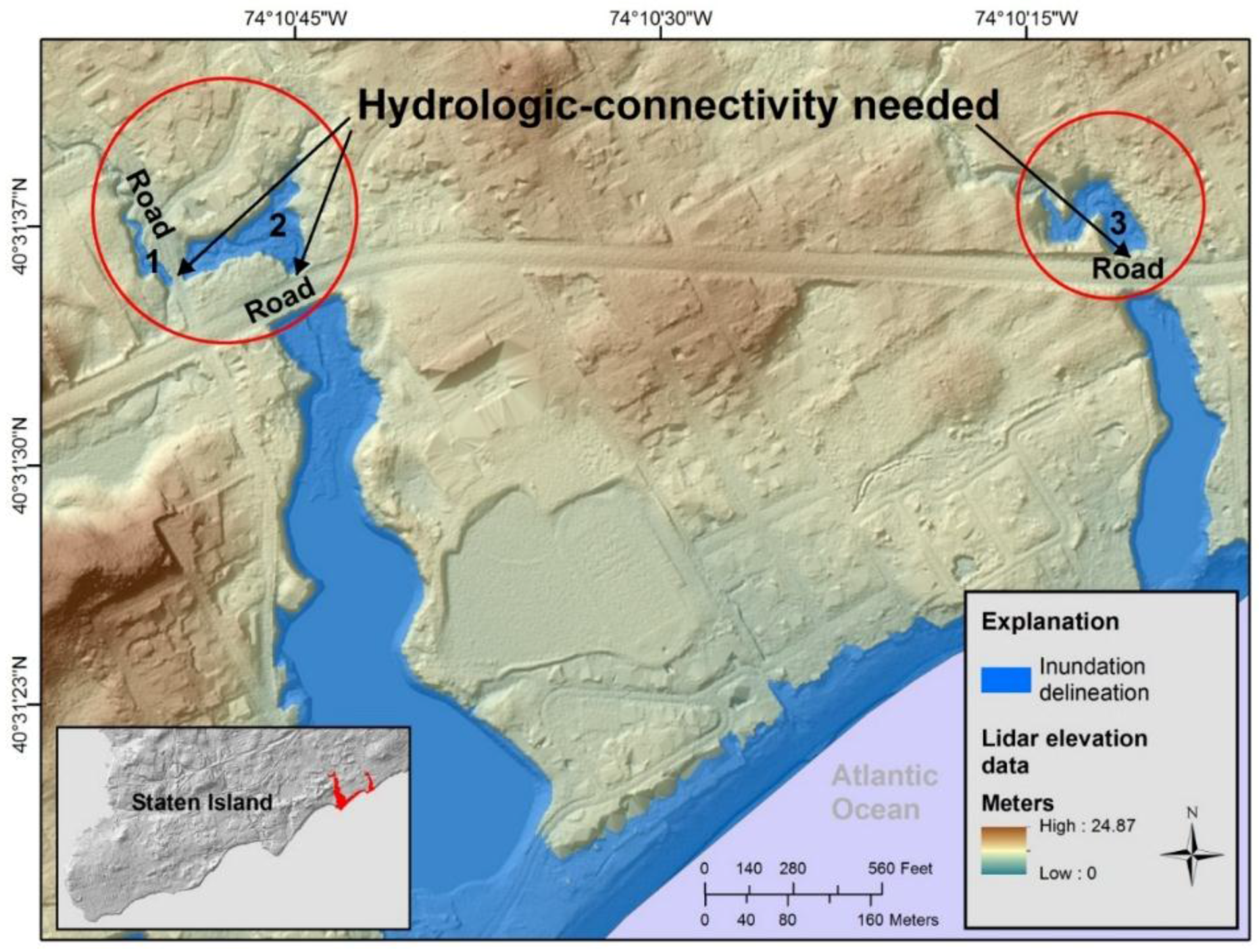


4.2. Types of Physical Surfaces Potentially Impacted
| National Oceanic and Atmospheric Administration Coastal Change Analysis Program (C-CAP)Regional Land Cover Classification | Area (km2) |
|---|---|
| Developed, Low Intensity | 0.0297 |
| Palustrine Forested Wetland | 0.0198 |
| Developed, Medium Intensity | 0.0171 |
| Deciduous Forest | 0.0171 |
| Developed Open Space | 0.0144 |
| Open Water | 0.0081 |
| Palustrine Emergent Wetland | 0.0063 |
| Palustrine Scrub/Shrub Wetland | 0.0009 |
| Total | 0.1134 |
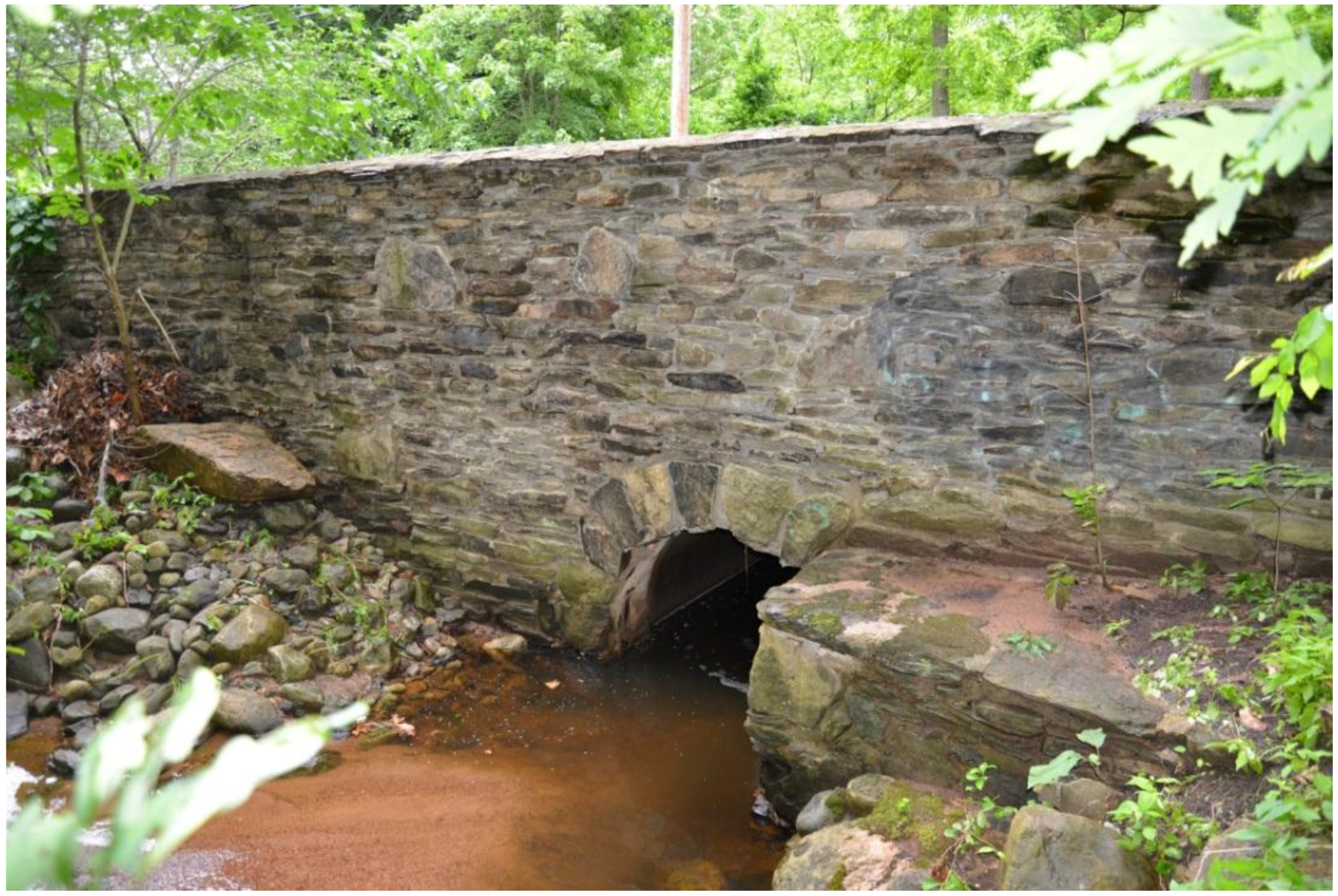


5. Conclusions
Acknowledgments
Author Contributions
Conflicts of Interest
References
- Burkett, V.R.; Davidson, M.A. Coastal Impacts, Adaptation and Vulnerability: A Technical Input to the 2013 National Climate Assessment; Island Press: Washington, DC, USA, 2012. [Google Scholar]
- Buxton, H.T.; Andersen, M.E.; Focazio, M.J.; Haines, J.W.; Hainly, R.A.; Hippe, D.J.; Sugarbaker, L.J. Meeting the Science Needs of the Nation in the Wake of Hurricane Sandy—A U.S. Geological Survey Science Plan for Support of Restoration and Recovery; U.S. Geological Survey Circular 1390; US Geological Survey: Reston, VA, USA, 2013.
- Brock, J.C.; Purkis, S.J. The emerging role of LiDAR remote sensing in coastal research and resource management. J. Coast. Res. 2009. [Google Scholar] [CrossRef]
- Gesch, D.B. Analysis of lidar elevation data for improved identification and delineation of lands vulnerable to sea level rise. J. Coast. Res. 2009. [Google Scholar] [CrossRef]
- Gesch, D.B.; Guiterezz, B.T.; Gill, S.K. Coastal elevations. In Coastal Sensitivity to Sea Level Rise: A Focus on the Mid-Atlantic Region; Titus, J.G., Anderson, K.E., Eds.; U.S. Climate Change Science Program: Washington, DC, USA, 2009; pp. 25–42. [Google Scholar]
- Benimoff, A.I.; Fritz, W.J.; Kress, M. Superstorm Sandy and Staten Island: Learning from the past, preparing for the future. In Learning from the Impacts of Superstorm Sandy; Bennington, J.B., Farmer, E.C., Eds.; Elsevier Inc.: New York, NY, USA, 2015; pp. 21–40. [Google Scholar]
- Brock, J.; Sallenger, A.H. Airborne Topographic Lidar Mapping for Coastal Science and Resource Management; U.S. Geological Survey Open File Report 2001–46; US Geological Survey: Reston, VA, USA, 2001.
- Gesch, D.B. Consideration of vertical uncertainty in elevation-based sea-level rise assessments: Mobile Bay, Alabama case study. J. Coast. Res. 2013. [Google Scholar] [CrossRef]
- Poppenga, S.K.; Worstell, B.B.; Stoker, J.M.; Greenlee, S.K. Using Selective Drainage Methods to Extract Continuous Surface Flow from 1-meter Lidar--Derived Digital Elevation Data; U.S. Geological Survey Scientific Investigations Report 2010–5059; US Geological Survey: Reston, VA, USA, 2010.
- Poppenga, S.K.; Worstell, B.B.; Stoker, J.M.; Greenlee, S.K. Using selective drainage methods to hydrologically-condition and hydrologically-enforce lidar-derived surface flow. In Proceedings of the Remote sensing and hydrology Symposium, Jackson Hole, WY, USA, 27–30 September 2010; pp. 329–332.
- FEMA. Guidelines and Standards for Flood Risk Analysis and Mapping. Available online: http://www.fema.gov/guidelines-and-standards-flood-risk-analysis-and-mapping (accessed on 10 February 2015).
- Poppenga, S.K.; Worstell, B.B. Hydrologic connectivity: A quantitative assessment of hydrologic-enforced drainage structures in an elevation model. J. Coast. Res. 2015, in press. [Google Scholar]
- Poppenga, S.K.; Worstell, B.B.; Danielson, J.J.; Brock, J.C.; Evans, G.A.; Heidemann, H.K. Hydrologic Enforcement of Lidar DEMs; U.S. Geological Survey Fact Sheet 2014–3051; US Geological Survey: Reston, VA, USA, 2014.
- ARCADIS U.S. Inc. ADCIRC Based Storm Surge Analysis of Sea Level Rise in Grand Bay; The Nature Conservancy: Arlington, VA, USA, 2011. [Google Scholar]
- MacDonald, T. Vulnerability and impacts on human development. In Coastal Impacts, Adaptation, and Vulnerabilities: A Technical Input to the 2013 National Climate Assessment; Burkett, V.R., Davidson, M.A., Eds.; NOAA: Washington, DC, USA, 2012; pp. 66–97. [Google Scholar]
- Karlin, A.; McClung, G.; Janke, J. Flood-prone area mapping: A case study. In Manual of Airborne Topographic Lidar; Renslow, M.S., Ed.; American Society for Photogrammetry and Remote Sensing: Bethesda, MD, USA, 2012; pp. 345–352. [Google Scholar]
- Kress, M.E.; Benimoff, A.I.; Fritz, W.J.; Thatcher, C.; Blanton, B.O.; Dzedzits, E. Modeling and simulation of storm surge on Staten Island to understand inundation analysis. J. Coast. Res. 2015. in review. [Google Scholar]
- Diaz-Nieto, J.; Lerner, D.N.; Saul, A.J.; Blanksby, J. GIS water-balance approach to support surface water flood-risk management. J. Hydrol. Eng. 2012, 17, 55–67. [Google Scholar] [CrossRef]
- Abdullah, A.F.; Vojinovic, Z.; Price, R.K.; Aziz, N.A.A. Improved methodology for processing raw LiDAR data to support urban flood modelling–accounting for elevated roads and bridges. J. Hydroinf. 2012, 14, 253–269. [Google Scholar] [CrossRef]
- Poulter, B.; Halpin, P.N. Raster modeling of coastal flooding from sea-level rise. Int. J. Geogr. Inf. Sci. 2008, 22, 167–182. [Google Scholar] [CrossRef]
- Gilmer, B.; Ferdana, Z. Developing a framework for assessing coastal vulnerability to sea level rise in southern New England, USA. In Resilient Cities 2: Cities and Adaptation to Climate Change—Proceedings of the Global Forum 2011; Otto-Zimmermann, K., Ed.; Springer: Dordrecht, The Netherlands, 2012; pp. 25–36. [Google Scholar]
- National Oceanic and Atmospheric Administration Coastal Services Center. Mapping Inundation Uncertainty. Available online: http://coast.noaa.gov/digitalcoast/_/pdf/ElevationMappingConfidence.pdf (accessed on 2 June 2015).
- U.S. Geological Survey. Hurricane Sandy. Available online: http://www.usgs.gov/hurricane/sandy/ (accessed on 12 May 2015).
- New York City Office of Emergency Management. NYC Hazards: NYC Hurricane History. Available online: http://www.nyc.gov/html/oem/html/hazards/storms_hurricanehistory.shtml (accessed on 20 May 2015).
- Woolpert. Lidar Point Cloud Data and Digital Elevation Model for Richmond County, New York. Available online: http://earthexplorer.usgs.gov/ (accessed on 10 February 2015).
- Woolpert. Airborne Lidar Task Order Report, New York CMGP Sandy 0.7 m NPS Lidar; Woolpert Project Number 73666; US Geological Survey: Rolla, MO, USA, 2014.
- McCallum, B.E.; Wicklein, S.M.; Reiser, R.G.; Busciolano, R.; Morrison, J.; Verdi, R.J.; Painter, J.A.; Frantz, E.R.; Gotvald, A.J. Monitoring Storm Tide and Flooding from Hurricane Sandy along the Atlantic Coast of the United States, October 2012; US Geological Survey Open-File Report 2013–1043; U.S. Geological Survey: Reston, VA, USA, 2013.
- U.S. Geological Survey. Sandy Mapper Database. Available online: http://water.usgs.gov/floods/events/2012/sandy/sandymapper.html (accessed on 11 March 2015).
- FEMA-MOTF. FEMA MOTF Hurricane Sandy Impact Analysis. Available online: http://www.arcgis.com/home/item.html?id=307dd522499d4a44a33d7296a5da5ea0 (accessed on 21 April 2015).
- U.S. Geological Survey. Storm Surge Sensors. Available online: http://www.usgs.gov/blogs/features/usgs_science_pick/usgs-storm-surge-sensors/ (accessed on 21 April 2015).
- Heidemann, H.K. Digital elevation models. In Manual of Airborne Topographic Lidar; Renslow, M.S., Ed.; American Society for Photogrammetry and Remote Sensing: Bethesda, MD, USA, 2012; pp. 283–310. [Google Scholar]
- U.S. Department of Agriculture, Natural Resources Conservation Service. Geospatial Data Gateway. Available online: https://gdg.sc.egov.usda.gov/ (accessed on 6 August 2015).
- National Oceanic and Atmospheric Administration. C-CAP FTP Download. Available online: http://coast.noaa.gov/ccapftp/ (accessed on 4 June 2015).
- Kress, M.; Benimoff, A.; (College of Staten Island, The City University of New York, Staten Island, New York, USA). Photographs of inland areas. 2015. [Google Scholar]
- New York City Department of Environmental Protection. Blue Heron, Arbutus Creek, and Lemon Creek/Sandy Brook Watershed Drainage Plans, Final Environmental Impact Statement; CEQR No. 97DEP026; City of New York: New York, NY, USA, 1998. [Google Scholar]
- Mason, D.C.; Horritt, M.S.; Hunter, N.M.; Bates, P.D. Use of fused airborne scanning laser altimetry and digital map data for urban flood modelling. Hydrol. Process. 2007, 21, 1436–1447. [Google Scholar] [CrossRef]
- Heidemann, H.K. Lidar Base Specification (version 1.2, November 2014); U.S. Geological Survey: Reston, VA, USA, 2014.
- Webster, T.L. Flood risk mapping using LiDAR for Annapolis Royal, Nova Scotia, Canada. Remote Sens. 2010, 2, 2060–2082. [Google Scholar] [CrossRef]
- Webster, T.L.; Forbes, D.L.; Dickie, S.; Shreenan, R. Using topographic LiDAR to map flood risk from storm surge events for Charlottetown, Prince Edward Island, Canada. Can. J. Remote Sens. 2004, 30, 54–76. [Google Scholar] [CrossRef]
© 2015 by the authors; licensee MDPI, Basel, Switzerland. This article is an open access article distributed under the terms and conditions of the Creative Commons Attribution license (http://creativecommons.org/licenses/by/4.0/).
Share and Cite
Poppenga, S.; Worstell, B. Evaluation of Airborne Lidar Elevation Surfaces for Propagation of Coastal Inundation: The Importance of Hydrologic Connectivity. Remote Sens. 2015, 7, 11695-11711. https://doi.org/10.3390/rs70911695
Poppenga S, Worstell B. Evaluation of Airborne Lidar Elevation Surfaces for Propagation of Coastal Inundation: The Importance of Hydrologic Connectivity. Remote Sensing. 2015; 7(9):11695-11711. https://doi.org/10.3390/rs70911695
Chicago/Turabian StylePoppenga, Sandra, and Bruce Worstell. 2015. "Evaluation of Airborne Lidar Elevation Surfaces for Propagation of Coastal Inundation: The Importance of Hydrologic Connectivity" Remote Sensing 7, no. 9: 11695-11711. https://doi.org/10.3390/rs70911695




